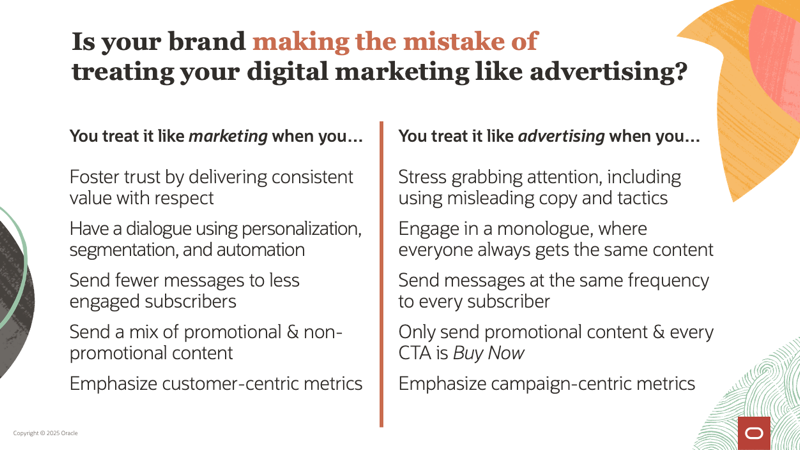Intrinsically, brands know that marketing and advertising are different functions with different goals and different strategies for achieving those goals. As different as they are, these two functions need to be coordinated. That’s why marketing and advertising are typically run out of the same group in most companies and overseen by the same executive officer.
However, perhaps because they’re increasingly organized under the same group, some brands are treating marketing like advertising. Chances are you regularly feel this when you personally receive email, SMS, and push messages that don’t reflect your interactions with those brands.
Operationally, there are several brand behaviors that tend to lead to marketing messages feeling like ads. Let’s talk about five of them.

Attention-Seeking vs. Value-Delivering
When marketing is treated like advertising, brands have lots of discussions about how to stand out and grab attention. Often this goal of being provocative turns into being misleading. Using a misleading email sender name, such a person’s name instead of your brand name. Using a “clever” subject line in an effort to get more opens, usually with the argument that “you can’t get clicks or conversions if they don’t open.”
However, when someone opts into your digital marketing program, that’s a signal that you already have their attention. To make the most of this marketing opportunity, brands have to focus on delivering value—ideally at the individual subscriber level, rather than generically at the overall audience level.
Another way to think about it is that while advertising’s job is to gain attention, marketing’s job is to not lose it by failing to deliver value or wasting a customer’s time with irrelevant offers or gimmicks that sacrifice subscriber trust.
Related post: Your Most Important Job as an Email Marketer Is…
Monologue vs. Dialogue
When marketing is treated like advertising, brands push a single message out to everyone. Moreover, that single message gets repeated multiple times for emphasis, because “not every subscriber opens every campaign.”
While repetition obviously has its place in marketing campaigns, the level of repetition that advertising uses to break through and grab attention is less appropriate in marketing campaigns. That’s because marketers have tactics that are multifold more effective than ad nauseam repetition—namely, personalization, segmentation, and automation.
By paying attention to a subscriber’s channel, web, app, and other behaviors, brands can appropriately react to their subscribers’ interests with tailored content. This boosts channel ROI significantly.
Related checklists: 110+ Automated Campaign Ideas and 170+ Segmentation & Personalization Ideas
One-Size-Fits-All Frequency vs. Not
When marketing is treated like advertising, brands send campaigns to everyone who’s opted in at the same frequency, even those subscribers who haven’t engaged in a long time. The reasoning is “Why would we send less to them? They opted in, so they expect to get all the campaigns. Plus, if we sent fewer campaigns, we’d be less of a presence in their inbox and they’d be even less likely to engage.”
Sometimes this same argument is used to justify sending additional campaigns to subscribers who are disengaged, with the goal of “forcing them to reengage or unsubscribe.”
However, part of the dialogue of digital marketing is paying attention to lulls in the conversation. If the lull is prolonged, that’s your sign to dial back on frequency. In channels like email, engagement rates are an important factor in deliverability, so it’s mathematically wise to mail disengaged subscribers less often so you don’t jeopardize your ability to reach your more engaged subscribers.
Beyond that, why would you want to badger disinterested subscribers into opting out when some patience and respect might give them the time they need to become interested again? Often, subscribers just need some time to find a new need, develop the need to replace an existing product, or get the money to be able to buy again.
Related post: Managing Inactive Subscribers: Both Long-Term Inactives and Never-Actives
All Promos vs. a Mix of Content
When marketing is treated like advertising, brands endlessly hammer the Buy Now! call-to-action. Every message is about getting the subscriber to spend money. The reasoning is “Revenue is our goal, so our messaging should be aligned to that.”
However, only a small percentage of your customers are in the market to buy at any given time. So, if you only include hard sell promotions in your campaigns, you train your subscribers to only open your emails when they’re actively considering buying.
Alternatively, if you provide a mix of promotional and non-promotional content in your campaigns, this gives all of your subscribers a reason to open and engage, even those who aren’t considering buying. Particularly valuable for sellers of long-lifespan products, this approach keeps your brand top of mind, builds trust and engagement, and keeps prospects warm until they’re ready to purchase again.
Plus, when subscribers engage with polls, industry news, educational content, and other non-promotional content, two magical things can happen. First, you gain engagement data that tells you what an individual subscriber is interested in, which can be used for future personalized, segmented, and automated campaigns. And second, by engaging with non-promotional content, subscribers who weren’t in the market may decide that they are because their interest has been piqued.
Related post: Messaging & Content Strategies for Long-Lifespan Products
Campaign- vs. Customer-Centric Metrics
When marketing is treated like advertising, brands focus on measuring the short-term impact of their marketing campaigns, like the clicks and revenue driven by each campaign. There are regular discussions about how far away the brand is to hitting its weekly, monthly, and quarterly digital marketing revenue goals and how many full-list ad hoc or retargeting campaigns should be sent to help close the gap.
However, operating with that lens naturally leads to over-sending, which increases subscriber churn and fatigue. In other words, it lowers long-term digital marketing revenue potential, making it harder for you to hit your future performance goals.
While advertising is mostly about addressing large audience segments, marketing is about serving individual subscribers and building a relationship that ideally spans years. While campaign performance is important and informative, marketers build healthier programs when they emphasize customer-centric metrics like lifetime value, revenue per subscriber, and average time on list.
After all, a modern marketer’s job isn’t to manage and optimize campaigns. It’s to manage and optimize subscriber relationships. Using customer-centric metrics aligns your metrics with your job.
Related post: Email List Churn: How to Reduce Both Passive & Active Opt-Outs
* * *
If your digital marketing program is emulating advertising programs in one or more of those ways, consider testing into changes that better align your program with marketing’s strengths and subscriber’s expectations. Long term, you’ll see much better results.
—————
Need help with your digital marketing campaigns? Oracle Digital Experience Agency has hundreds of marketing and communication experts ready to help Responsys, Eloqua, Unity, and other Oracle customers create stronger connections with their customers and employees—even if they’re not using an Oracle platform as the foundation of that experience. With a 94% satisfaction rate, our clients are thrilled with the award-winning work our creative, strategy, and other specialists do for them, giving us an outstanding NPS of 82.
For help overcoming your challenges or seizing your opportunities, talk to your Oracle account manager, visit us online, or email us at OracleAgency_US@Oracle.com.
To stay up to date on customer experience best practices and news, subscribe to Oracle Digital Experience Agency’s award-winning, twice-monthly newsletter. View archive and subscribe →
